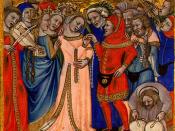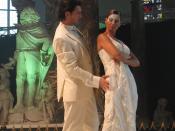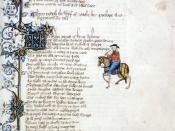Alison, the Wife of Bath, was a radical thinker of her time and was probably considered by Chaucer's readers to be promiscuous and even blasphemous. She establishes herself as an authority on all matters of marriage. Women, in the time of Chaucer, were cast into very specific roles. In her prologue, the Wife of Bath addresses the general code of conduct and other commonly accepted behaviors of women and dismisses them to justify and rationalize her own life style of being married many times.
Women at that time were expected to live lives of purity, holiness, and service to others. Many of these gender-based expectations stemmed from the church and biblical history, as modeled by the Virgin Mary; these ideas about marriage had been in place since the time of St. Jerome. The Wife of Bath challenged these beliefs that were blindly accepted around her, and did so without a second thought (http://jade...).
The first argument of the church against her that she mentions is the wedding at Cana as recorded in John 2:11; this is the only wedding that Jesus ever attended in His recorded life. Though saying nothing of the commitment and sacrament of marriage, the medieval interpretation of this passage is that since Christ only went to one wedding, one should be married only one time. The next argument she mentions in her prologue is about the time when Jesus encountered the Samaritan adulteress at the well as told in John 4:4-42, and how the woman, having been married five times, had no true husband anymore. This is the argument that the church used against having more than one husband; that any more than one being an invalid marriage in the eyes of Christ.
These two instances fail to have a basis in our modern understanding of...


